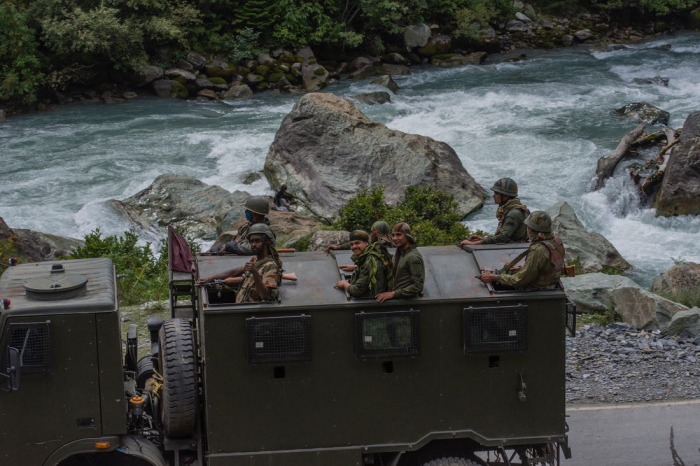As tension between India and China has increased in recent months, the US military has helped India keep an eye on Chinese forces, senior US military commanders said in November.
A deadly brawl on India and China's disputed border in the Himalayas in June was their first such clash in decades. Since then both have reinforced their positions, and India has had help monitoring Chinese forces.
"From the real-world standpoint, we've gotten closer this year with India, especially on the intelligence sharing, particularly related to the situation that's occurring on their northeast border with China," Gen. Kenneth Wilsbach, head of US Pacific Air Forces, said at an event in November.
"We've been doing quite a bit of intelligence sharing, as much as we can, with them to help out our great friend, India," added Wilsbach, who took command in July.
That sharing likely has been facilitated in recent weeks by the Basic Exchange and Cooperation Agreement, a military agreement the US and India signed in late October.
BECA "will allow us to expand our partnership and exchange foundational information," Vice Adm. Robert Sharp, director of the National Geospatial-Intelligence Agency and the US signatory on the deal, said at a separate event last month.
BECA gives India access to topographical, nautical, and aeronautical data and allows the US to provide advanced navigational aids and avionics, a defense industry source told Reuters ahead of the signing. Geospatial data provided under the deal will give Indian missiles "a killer edge" in targeting, as one Indian media outlet put it.
"That exchanging and sharing of foundational information is a good basis to start to operate ... off the same map," Sharp said.
Crossing the hump
BECA is the fourth of four foundational agreements. A 2002 deal allowed sharing of classified military information. A 2016 logistics deal allows each military to use the other's facilities for repair or resupply. A third deal in 2018 gave India access to secure communications equipment, allowing closer coordination with US forces.
There have already been demonstrations of cooperation under these deals. US ships have refueled Indian warships, and a US maritime patrol aircraft recently refueled in the Andaman and Nicobar Islands in the eastern Indian Ocean, which the US government called "a historical event."
The agreements are a sign of India softening the strict non-aligned stance it held throughout the Cold War, which is driven in part by recent US overtures and Chinese aggressiveness.
"These two complimentary forces, I think, are pushing India toward sort of more overt balancing activities and more confidence in establishing a meaningful strategic partnership with the US," said Jeff Smith, a research fellow at the Heritage Foundation think tank.
The shift reflects "a revolution in the way that India views the world and aligns with partners in Asia," Hervé Lemahieu, director of the Power and Diplomacy Program at Australia's Lowy Institute think tank, said in October.
India "has chosen to align itself with the United States far more assertively, and with countries like Australia, with whom it doesn't really have much of a traditional relationship," Lemahieu told Insider.
Disputed land borders with Pakistan and China are likely to remain the Indian military's major focus, but New Delhi is increasingly active in the Indian Ocean — where China's military and diplomatic presence is growing — bolstering its own forces as well as its cooperation with others.
The meeting where BECA was signed also reportedly included a maritime information-sharing agreement, allowing India to better track activity in the Indian Ocean. India's Information Fusion Center-Indian Ocean Region, set up two years ago, now has 21 countries sharing information on maritime activity in the area.
Indian foreign aid, meant to counter Chinese lending, also continues to flow despite recent economic headwinds. "That tells you, I think, how important building these relationships are to India in terms of countering China in the region," Rani Mullen, a professor at William and Mary and expert on South Asia, said at a recent think-tank event.
India is "is deepening its defense diplomacy" and "being more ambitious" with those partnerships, Lemahieu said, but there are still questions about how India will apply the agreements it spent two decades negotiating with the US.
"We went on for years negotiating over the dots and the T's ... and I guess in some ways it's a good thing that we've crossed that hump," Ashley Tellis, an expert on international security at the Carnegie Endowment for International Peace, said at an event in November.
"Now the question to my mind is, OK, you've done the agreements. What are you going to do about them? How are you actually going to implement them?" Tellis added. "This is where I think India still has a long ways to go."
In the weeks since signing BECA, India has leased two US-made MQ-9B surveillance drones to monitor its maritime and land boundaries, an acquisition facilitated by policy changes in both countries. Those exchanges and others under the foundational agreements will likely inspire more trust, feeding a "virtuous cycle," Smith said.
"In many cases, India benefits more than the US does from these military cooperation agreements," Smith told Insider. "The practitioners are operationalizing these agreements and realizing that it brings real benefit to India."
Business Insider
More about:
















































